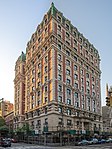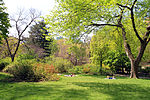The San Remo
1929 establishments in New York (state)Central Park West Historic DistrictCondominiums and housing cooperatives in ManhattanEmery Roth buildingsHistoric district contributing properties in Manhattan ... and 10 more
Historic district contributing properties in New York (state)Historic district contributing properties in New York CityNew York City Designated Landmarks in ManhattanResidential buildings completed in 1929Residential buildings on the National Register of Historic Places in ManhattanResidential skyscrapers in ManhattanTwin towersUpper West SideUse mdy dates from August 2019Vague or ambiguous time from February 2022

The San Remo is a luxury 27-floor co-operative apartment building at 145 Central Park West, between West 74th and 75th Streets, on the Upper West Side of Manhattan in New York City. Opened in 1930, the San Remo is described by Glen Justice of the New York Times as "a dazzling two-tower building with captivating views of Central Park." As a housing cooperative, its board has a reputation for "lenient admissions standards" compared to the conservative, old-money boards on the other side of the park.
Excerpt from the Wikipedia article The San Remo (License: CC BY-SA 3.0, Authors, Images).The San Remo
Central Park West, New York Manhattan
Geographical coordinates (GPS) Address External links Nearby Places Show on map
Geographical coordinates (GPS)
| Latitude | Longitude |
|---|---|
| N 40.778036 ° | E -73.974971 ° |
Address
The San Remo
Central Park West 145-146
10023 New York, Manhattan
New York, United States
Open on Google Maps






